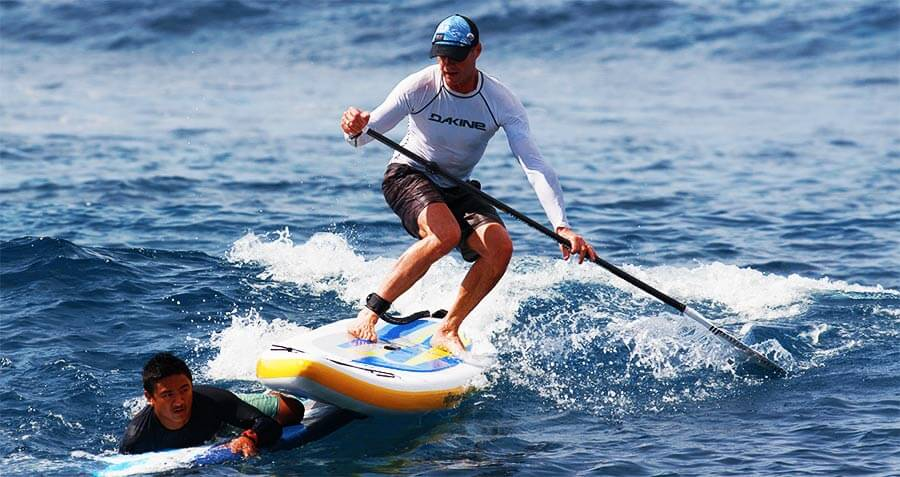Stand-up paddle boarding (SUP) is an enjoyable activity for beginners and seasoned enthusiasts alike. It’s a great way to explore new locations, get a workout, and relieve stress. However, beginners often make mistakes that can turn a fun experience into a challenging one. To ensure a safe and enjoyable time on the water, here’s a guide to common paddleboard mistakes to avoid.
Common Mistakes by Beginner Paddlers
Choosing the Wrong Paddle Board
Selecting the right paddle board is crucial for a successful experience. Paddle boards come in various sizes and types, such as epoxy and inflatable boards. For beginners, inflatable paddleboards are ideal due to their safety, lighter weight, and portability.
For stability and support, beginners should consider the following dimensions:
- Length: 10’-11’
- Width: at least 31”
- Thickness: 6”
Ensure the board can accommodate your weight by choosing one with a volume at least twice your weight. Avoid overloading the board, as this can affect paddling and stability.
Facing Your Paddle Board Backwards
A paddle board has a narrow nose at the front and a wider tail at the back. Always face the front of the board; paddling against the fins can cause the board to turn unexpectedly, leading to a fall.
Using the Wrong Paddle Size
An incorrectly sized paddle can strain your shoulders and back. For recreational paddling, a paddle should be about 8” taller than you.
Facing the Paddle’s Blade Backwards
To paddle in a straight line, keep the inside curve of the paddle blade facing away from you. Holding the blade backwards will make the paddle less effective, dragging you down.
Standing Too Far Forward on the Board
For efficient paddling, stand on the center of the board where the carry handle is located. Standing too far forward can cause you to lose balance, while standing too far back may cause the tail to sink and increase drag.
Fitness and Posture Mistakes
Holding the Paddle Incorrectly
Grip the top of the paddle with your dominant hand and the center of the shaft with your other hand. Your arms should be shoulder-width apart, with elbows at 90° angles.
Incorrect Paddle Boarding Technique
Hold the paddle perpendicular to the board, keeping it close to you to maintain balance. With slightly bent elbows, dip the paddle into the water, and push it back to your hip. Use your core and legs to power the stroke, not just your arms.
Poor Balance Techniques
Stand with your feet shoulder-width apart, toes facing forward, and knees slightly bent. This stance helps distribute your weight evenly and maintain balance. Always look towards the horizon to avoid losing balance and missing obstacles.
Safety Mistakes
Not Wearing Safety Gear
Always wear a life jacket and an ankle leash. A life jacket is crucial for safety in rough waters, while a leash prevents your board from drifting away if you fall.
Not Checking the Weather Forecast
Bad weather can quickly turn your paddle boarding adventure dangerous. Check the wind, weather forecast, and water temperature before heading out. Avoid paddling in conditions with strong wind, high waves, or approaching storms. Paddle upwind to make your return easier.
Wearing the Wrong Clothing
Wear clothing suitable for the weather conditions. Opt for warm layers in cold weather and moisture-wicking fabric in hot weather. Avoid cotton, and always be prepared to swim.
Paddle Boarding in Shallow Water
Avoid paddling in water less than 20-30 inches deep, as it may contain obstacles like rocks or branches that can damage your board and increase your risk of injury.
Falling on the Board Instead of in the Water
If you fall, try to fall sideways into the water rather than on the board to avoid injury and damage. Never dive in, as you may not know the depth or if there are obstacles.
Equipment and Maintenance Mistakes
Not Inflating Your Paddle Board Correctly
Inflatable paddle boards have a recommended PSI (pounds per square inch) that ensures proper rigidity. Under-inflation makes the board floppy, while over-inflation can cause damage.
Leaving Your Board in the Sun
Store your paddle board in a cool, dry place. Direct sunlight can heat the air inside the board, stressing the seams and causing potential damage.
Dragging the Board
Dragging your board can scratch or damage it. Carry it under your armpit or use a friend’s help. Inflatable boards are easier to transport and less likely to be damaged.
FAQs
Why Am I So Wobbly on a Paddle Board?
Wobbliness can result from using the wrong stance, incorrect board size, improper paddling technique, or choppy waters.
Why Is My Paddle Board Bowing in the Middle?
Overloading the board, insufficient inflation, or poor storage can cause bowing.
Why Does My Paddle Board Deflate When I Take the Pump Out?
If air rushes out when removing the pump, the valve pin might be open or there could be a hole in the board.By avoiding these common mistakes and following proper techniques, you can have a safer and more enjoyable time on your paddle board.
Sign up for our Daily newsletter
We'll be in your inbox every morning Monday-Saturday with all the day’s top business news, inspiring stories, best advice and reporting from Entrepreneur,


